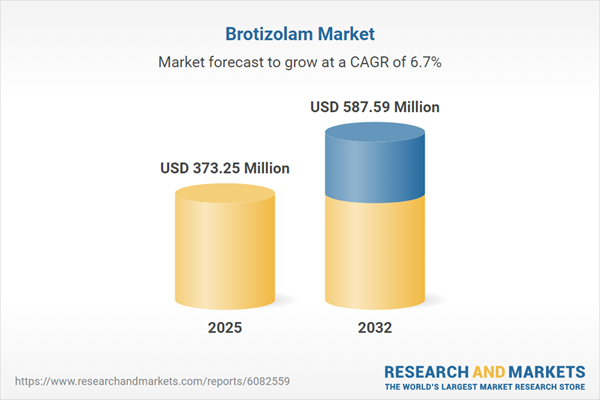Speak directly to the analyst to clarify any post sales queries you may have.
The Brotizolam market is advancing as a result of ongoing regulatory changes, shifts in clinical practice, and evolving patient needs. Executives in the pharmaceutical sector must stay informed on transformative trends, competitive dynamics, and actionable strategies to foster growth in the sleep therapeutics landscape.
Market Snapshot – Brotizolam Market Growth and Trajectory
The global Brotizolam market expanded from USD 350 million in 2024 to USD 373.25 million in 2025, and is projected to reach USD 587.59 million by 2032 at a compound annual growth rate (CAGR) of 6.69%. This reflects sustained demand for effective insomnia management solutions, driven by ongoing clinical research, regulatory evolution, and increased adoption in various regions.
Brotizolam Market Scope & Segmentation
- Treatment Duration: • Long-term: Chronic Insomnia Treatment • Short-term: Acute Insomnia Treatment; Situational Insomnia Treatment
- Product Type: • Branded • Generic
- Distribution Channel: • Hospital Pharmacy: Private Hospital; Public Hospital • Online Pharmacy: E Pharmacy Platform; Telemedicine Pharmacy • Retail Pharmacy: Chain Pharmacy; Independent Pharmacy
- End User: • Clinics • Homecare • Hospitals
- Dosage Strength: • 0.125 mg • 0.25 mg • 0.5 mg
- Formulation: • Capsules • Sublingual Tablets • Tablets
- Region: • Americas: United States, Canada, Mexico, Brazil, Argentina, Chile, Colombia, Peru • Europe, Middle East & Africa: United Kingdom, Germany, France, Russia, Italy, Spain, Netherlands, Sweden, Poland, Switzerland, United Arab Emirates, Saudi Arabia, Qatar, Turkey, Israel, South Africa, Nigeria, Egypt, Kenya • Asia-Pacific: China, India, Japan, Australia, South Korea, Indonesia, Thailand, Malaysia, Singapore, Taiwan
- Companies Covered: • Sumitomo Dainippon Pharma Co., Ltd., Teva Pharmaceutical Industries Ltd., Sandoz International GmbH, Viatris Inc., Sun Pharmaceutical Industries Ltd., Dr. Reddy’s Laboratories Ltd., Lupin Limited, Apotex Inc., Torrent Pharmaceuticals Ltd., Glenmark Pharmaceuticals Ltd.
Brotizolam Market: Key Takeaways for Senior Leaders
- Strategic alignment around clinical developments and regulatory adjustments remains essential for effective portfolio management in the competitive sleep therapeutics segment.
- Personalized medicine is driving differentiated product offerings, including improved-release forms and sublingual delivery, which can positively influence patient adherence and market adoption.
- Digital health and telemedicine are expanding access across regions, while modular and continuous production strategies are improving supply chain flexibility.
- Segment differentiation around branded versus generic options informs reimbursement strategy and market exclusivity, offering new levers for organizational growth.
- Formulation innovation and localized partnerships are increasingly influential in regions such as Asia-Pacific, where government initiatives and generic competition spur rapid market evolution.
- Investing in risk management, including dual sourcing and supply chain resilience, is critical in responding to evolving global tariff and regulatory landscapes.
Tariff Impact and Supply Chain Adaptation
Recent U.S. tariff increases have heightened import costs for key raw materials and active pharmaceutical ingredients, prompting manufacturers to reassess supply agreements and diversify sourcing strategies. Both distributors and wholesalers are adapting their pricing models to maintain affordability amid input cost fluctuations. In this context, regional consolidation, dual sourcing, and risk management have become central to ensuring long-term supply chain stability and protecting market position.
Research Methodology & Data Sources
This report utilizes a comprehensive blend of primary and secondary research. Primary data derives from structured interviews with pharmaceutical executives, contract manufacturers, and distribution stakeholders, providing strategic insight into market dynamics and clinical priorities. Secondary research encompasses peer-reviewed literature, regulatory filings, and market analysis frameworks, including SWOT, PESTEL, and Porter’s Five Forces. Quality assurance protocols, including data triangulation and peer review, underpin the reliability of all findings.
Why This Report Matters
- Enables data-driven decisions with detailed segmentation, competitor activity, and regional trend analysis in the Brotizolam market.
- Equips leadership with actionable intelligence to optimize portfolios, mitigate tariff or regulatory risks, and accelerate emerging market access.
- Supports proactive supply chain and product development strategies to capture growth opportunities and reinforce market resilience.
Conclusion
The Brotizolam market is poised for continued evolution, influenced by innovation, regulatory landscapes, and patient-centric approaches. Senior decision-makers equipped with this insight can shape active strategies to drive value and strengthen market presence.
Table of Contents
3. Executive Summary
4. Market Overview
7. Cumulative Impact of Artificial Intelligence 2025
Companies Mentioned
The companies profiled in this Brotizolam market report include:- Sumitomo Dainippon Pharma Co., Ltd.
- Teva Pharmaceutical Industries Ltd.
- Sandoz International GmbH
- Viatris Inc.
- Sun Pharmaceutical Industries Ltd.
- Dr. Reddy’s Laboratories Ltd.
- Lupin Limited
- Apotex Inc.
- Torrent Pharmaceuticals Ltd.
- Glenmark Pharmaceuticals Ltd.
Table Information
| Report Attribute | Details |
|---|---|
| No. of Pages | 185 |
| Published | October 2025 |
| Forecast Period | 2025 - 2032 |
| Estimated Market Value ( USD | $ 373.25 Million |
| Forecasted Market Value ( USD | $ 587.59 Million |
| Compound Annual Growth Rate | 6.6% |
| Regions Covered | Global |
| No. of Companies Mentioned | 11 |









